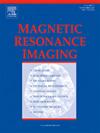A concentric-loops coil enhancing RF coil B1 efficiency and reducing imaging noise compared to traditional single-loop coil
IF 2
4区 医学
Q2 RADIOLOGY, NUCLEAR MEDICINE & MEDICAL IMAGING
引用次数: 0
Abstract
We proposed a simple approach to optimize a concentric-loops RF coil, consisting of an inner primary coil as the driving coil and an outer secondary coil as a passive resonator. By adjusting the tuning capacitor in the secondary loop to raise its self-resonance frequency to be slightly above the operating Larmor frequency, we enabled the preferred operation condition (additive mode), where both secondary and primary loops contributed to the largely enhanced RF coil transmit and receive magnetic fields (B1) within the area enclosed by the primary loop as compared to a single-loop secondary coil. Compared to a single secondary loop coil as control, electromagnetic (EM) simulations and phantom MRS/MRI at 10.5 Tesla (T) 17O (60.6 MHz), 7 T 31P (120.7 MHz), and 1.5 T 1H (63.8 MHz) operating frequencies show that the concentric-loops coil (8 cm diameter for the secondary loop coil) provides 1.2 to 1.4-fold higher B1 and coil detection sensitivity in the near-coil region (0–3 cm). In the far region, it offers slightly enhanced B1 and coil sensitivity, which becomes similar to the control coil at 9 cm away from the coil plane. Additionally, the concentric-loops coil reduces imaging noise by 15–30 %, collectively, resulting in an ∼1.7-fold signal-to-noise ratio (SNR) gain at the near-coil region. The concentric-loops coil with the presented optimization strategy provides an effective and simple coil design with largely improved imaging SNR compared to a conventional single-loop coil for a broad range of MRS/MRI applications across different field strengths.
与传统的单回路线圈相比,同轴线圈提高了射频线圈B1的效率,降低了成像噪声。
我们提出了一种优化同心环射频线圈的简单方法,该线圈由内部初级线圈作为驱动线圈和外部次级线圈作为无源谐振器组成。通过调整次级回路中的调谐电容器,使其自谐振频率略高于工作拉莫尔频率,我们启用了首选的工作条件(加性模式),其中次级回路和初级回路与单回路次级线圈相比,在初级回路包围的区域内,大大增强了射频线圈的发射和接收磁场(B1)。与单个次级回路线圈作为控制相比,在10.5 T 17O(60.6 MHz)、7 T 31P(120.7 MHz)和1.5 T 1H(63.8 MHz)工作频率下的电磁(EM)模拟和模态MRS/MRI表明,同心环路线圈(次级回路线圈直径8 cm)在近线圈区域(0-3 cm)提供了1.2至1.4倍的B1和线圈灵敏度。在远端区域,它提供了稍微增强的B1和线圈灵敏度,这变得类似于控制线圈在9 厘米远离线圈平面。此外,同心环线圈将成像噪声降低了15- 30% %,从而在近线圈区域获得了~1.7倍的信噪比增益。与传统的单环路线圈相比,具有优化策略的同心环路线圈提供了一种有效且简单的线圈设计,在不同场强的广泛MRS/MRI应用中大大提高了成像信噪比。
本文章由计算机程序翻译,如有差异,请以英文原文为准。
求助全文
约1分钟内获得全文
求助全文
来源期刊

Magnetic resonance imaging
医学-核医学
CiteScore
4.70
自引率
4.00%
发文量
194
审稿时长
83 days
期刊介绍:
Magnetic Resonance Imaging (MRI) is the first international multidisciplinary journal encompassing physical, life, and clinical science investigations as they relate to the development and use of magnetic resonance imaging. MRI is dedicated to both basic research, technological innovation and applications, providing a single forum for communication among radiologists, physicists, chemists, biochemists, biologists, engineers, internists, pathologists, physiologists, computer scientists, and mathematicians.
 求助内容:
求助内容: 应助结果提醒方式:
应助结果提醒方式:


